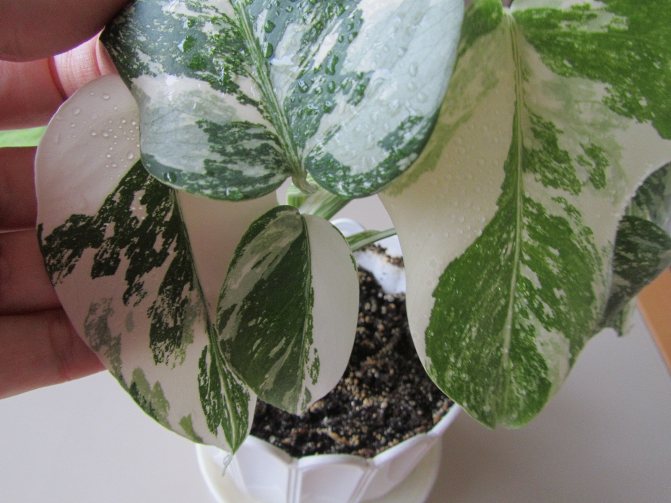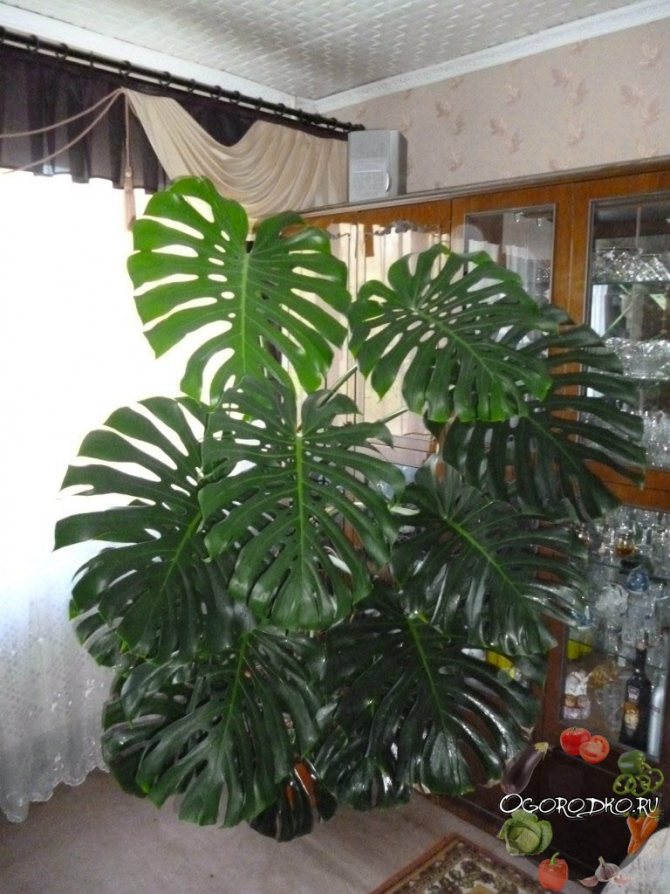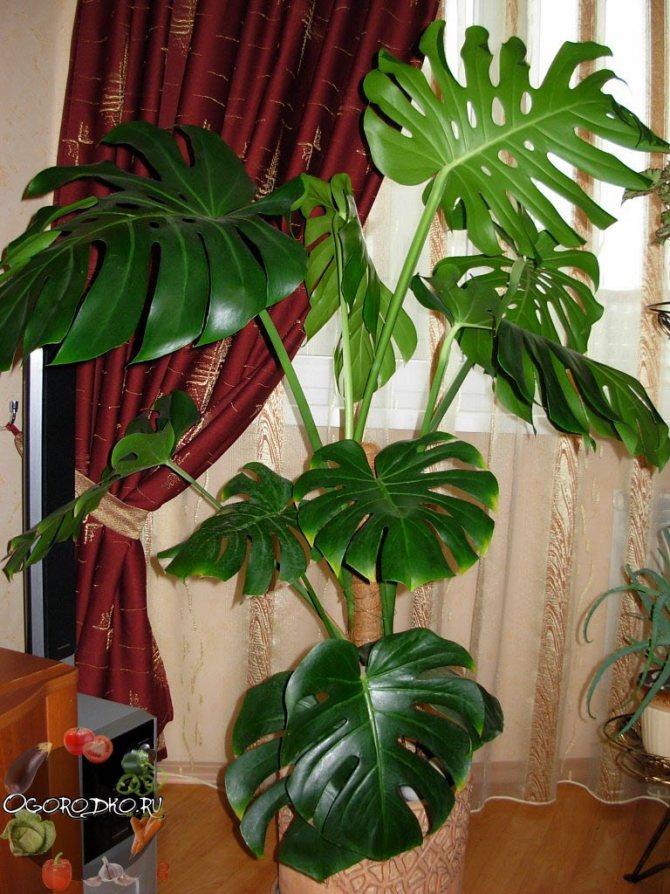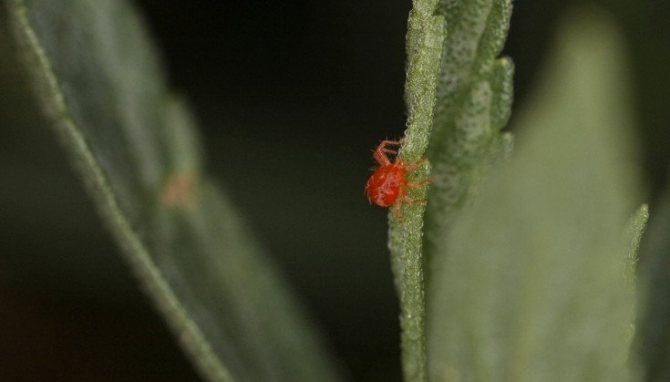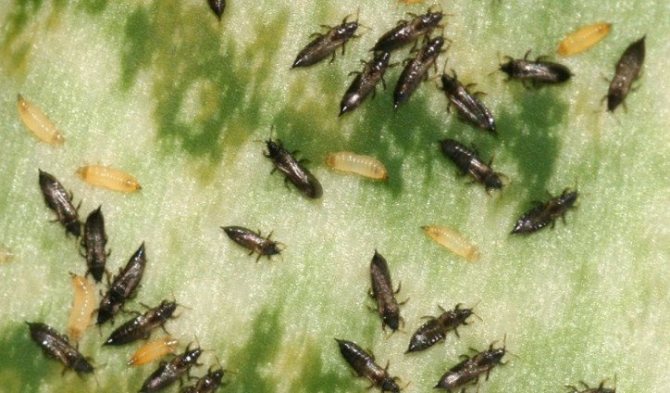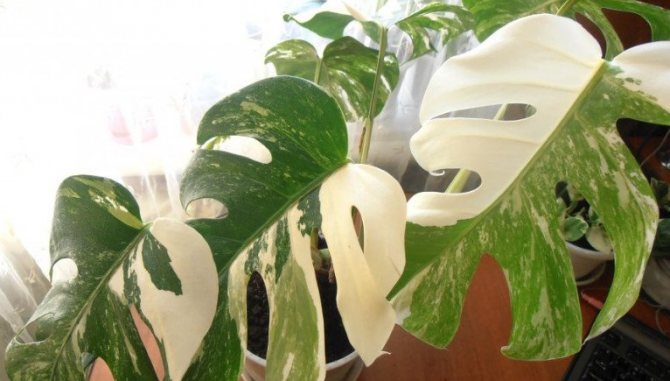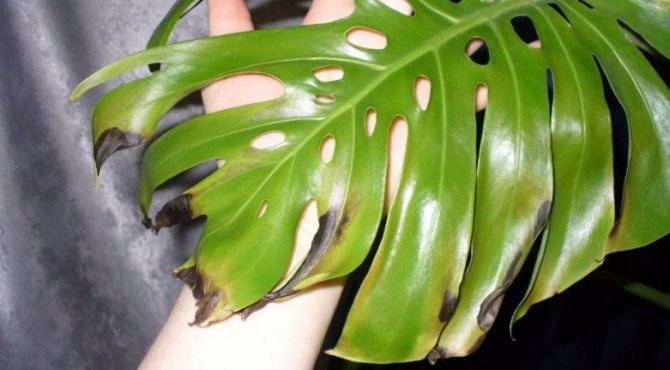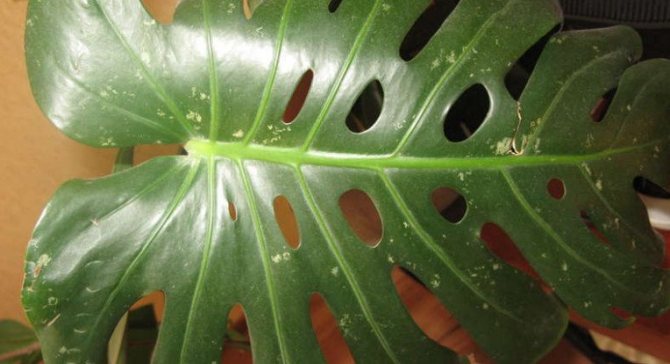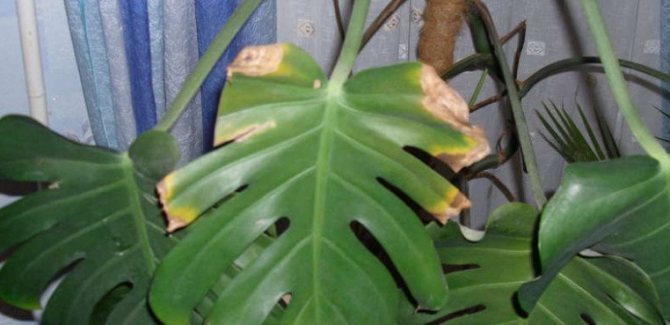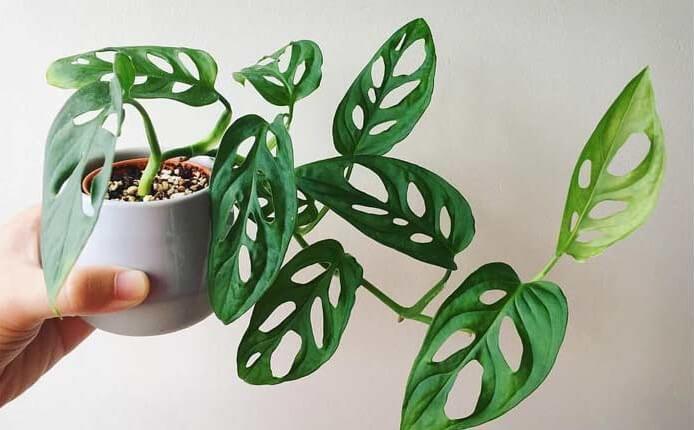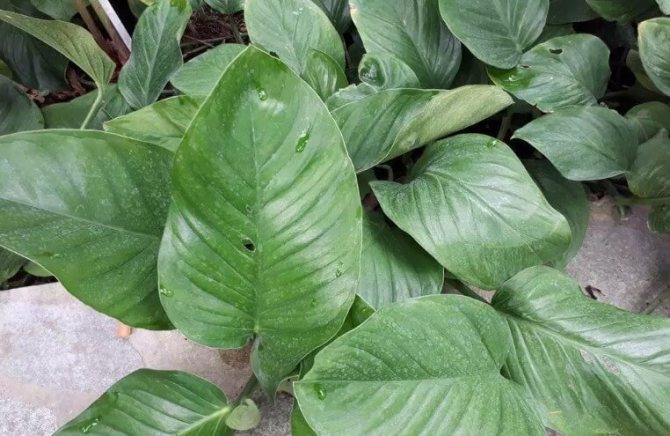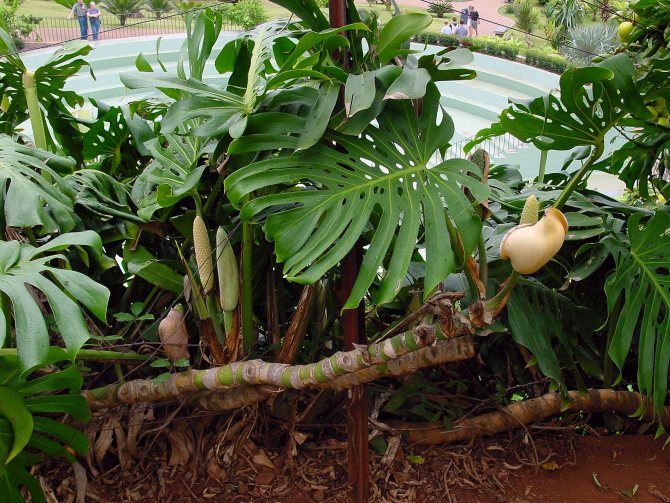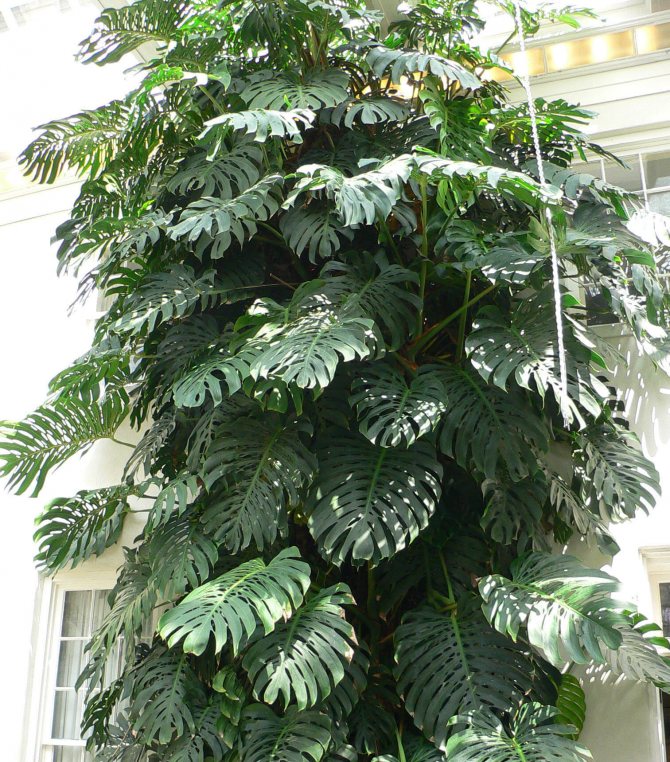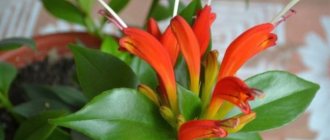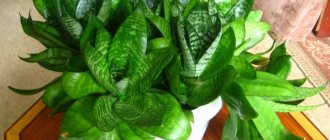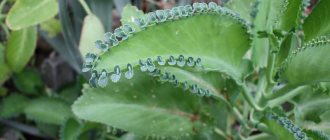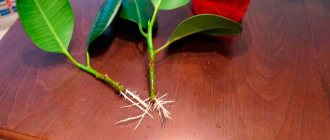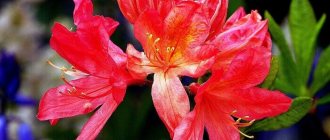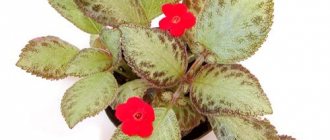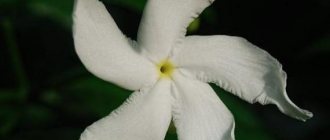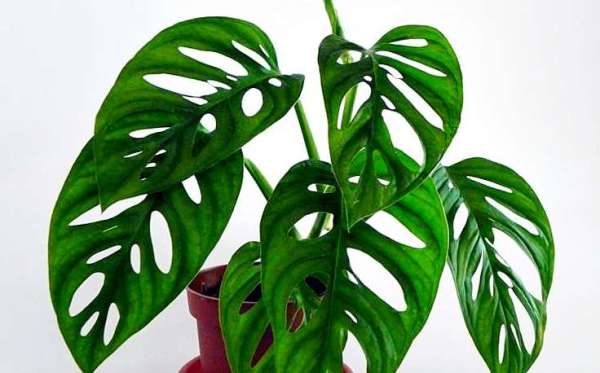
Monstera is a tropical vine native to South America. It has large, heart-shaped leaves of a deep green color with cuts. An adult plant can grow to a height of over six meters. Flower
Monstera is a cream-colored ear. At the end of flowering, it forms a fruit that is considered edible.
The name of the plant was formed from the Latin word "monstrosus", which in translation means - amazing or bizarre.
Monstera leaves ionize and purify the air... For this reason, it is advised to plant the plant in the houses of large cities. When grown at home, the plant requires special care.
Plant care at home
The basic rules of content are reduced to creation of natural conditionswhere Monstera lives.
Lighting
For healthy growth, Monstera needs bright, diffused light. The plant does not tolerate shade in the same way as direct sunlight.
In low light, flower leaves stop growing and do not form cuts... And with an excess of light, the plant turns pale and becomes covered with yellow spots.
In winter, when the day is short, an additional light source must be provided.
Temperature
Tropical liana loves warmth the higher the temperature, the faster the growth... Florists recommend maintaining the temperature within 17-22 degrees in winter and from 22 to 25 degrees in summer. Drafts are strictly prohibited for the plant.
Watering and humidity
Water the Monster often and a lot, especially in spring and summer, when the stage of active growth begins. In winter, watering is reduced. The main thing is that the soil in the pot always remains moist.
For irrigation, take settled water at room temperature. Spraying and wiping the leaves is mandatory once a week. If there is dry air in the room, a container with water is installed next to the plant.
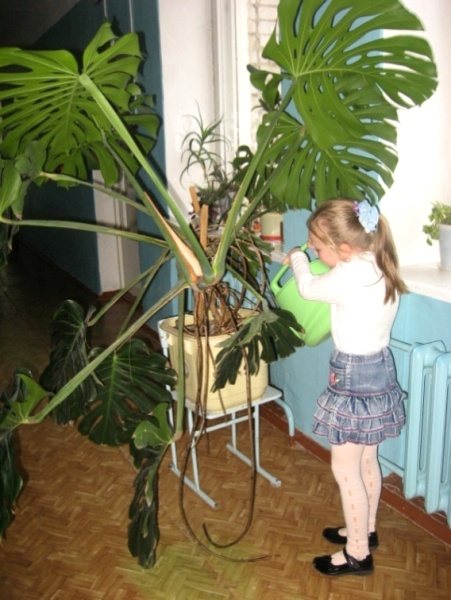

Watering monstera
Soil and fertilizer
The correct soil composition for Monstera must necessarily include equal parts:
A 5-7 cm thick expanded clay drainage layer is laid at the bottom of the pot.
This rule especially applies to the period from March to September. In winter, feeding is done less often.
Pot
The container for Monstera needs a wide one so that the air roots growing from the stem can take root in the ground in the future.
The material of the flowerpot does not matter... The depth of the pot should match the size of the root system. And one more rule when choosing a container is stability. Otherwise, heavy leaves and stems can knock it over.
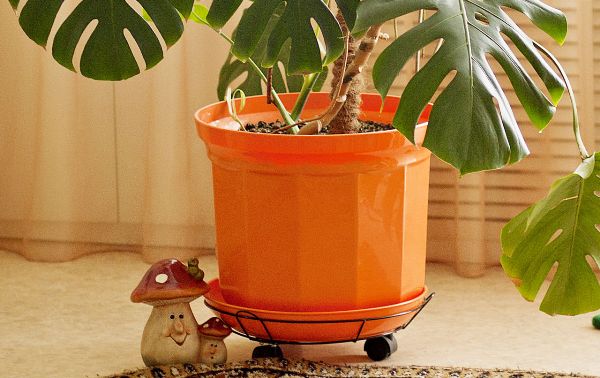

Wide stable pot for monstera
How to properly prune a monster
Pruning the plant is optional. This procedure is carried out to achieve curvaceous forms and branching Monsters. To form several stems, at the initial stage of development, the top of the flower is cut off.
To avoid infection, the procedure is carried out with a sterile blade, and charcoal is sprinkled over the cut site. Over time, side shoots grow on the stem.
After all the activities, you must thoroughly wash your hands, as Monstera juice has poisonous properties and can lead to skin burns.
How to transplant a flower
Monstera due to its impressive size needs a regular transplant... Such an event will help maintain the health and accelerate the growth of the plant.
This is done in early spring, until the active growth stage has begun. Monsters, whose age has crossed the three-year milestone, are recommended to be transplanted once every 3 years. In this case, it is necessary each time to replace part of the old soil with a new one.
Before starting the transplant, you need to take care of the dishes, they should be at least 7-10 centimeters larger than the previous one. A drainage layer of small stones or expanded clay must be laid in the pot. Then, ready-made fertile soil is poured onto half of the dishes. A lump with roots and remnants of old soil is placed in it and covered with the second part of the soil. After the done actions, Monstera is poured abundantly with water.
Reproduction
There are several ways to breed vines:
- Propagation by air layers... To do this, there must be at least one aerial root and one leaf on the layer. The cuttings are cut off and placed in a bowl with nutritious and moistened soil. During this period, it is important to maintain the temperature at 17-22 degrees. You can cover the future flower with a film to prevent a draft. After the cuttings have taken root, they are grown according to the general rules of care.
- Propagation by cuttings... To achieve the result, the stem or lateral processes are cut off. First, the soil is prepared from equal parts of humus and sand. Then the cutting is immersed in it and poured abundantly with room water. After the manipulations done, the pot with cuttings is closed with glass and placed in a well-lit place. From this moment on, watering is done daily. As soon as Monstera gives roots, it is transplanted into a separate flowerpot.
- Seed propagation... This method is recognized as the most successful, but time-consuming. First of all, you need to purchase seeds that are not more than 1 year old. They are soaked in herbal solution and sown in nutrient soil. From the moment of planting to the moment of the first shoots, it takes at least a month. All this time, the container with seeds must be kept in the shade, warmth and moisture.
For young Monsters to reach at least 9-10 sheets, at least a couple of years must pass. Florists claim that a vine grown in this way will be strong and beautiful.
Problems and illnesses
Like other indoor flowers, Monstera is susceptible to disease and pest attacks. In order to protect the plant from such problems, a number of rules must be followed:
- Yellowed plant leaves indicate over-watering... To prevent the death of the flower, you should reduce the amount of water and, if possible, transplant it into new soil.
- If brown spots appear on yellowed leaves, then Monstere not enough moisture... Abundant watering and spraying will help to correct the situation.
- The leaves turned yellow and fell. The reason is in the heat and dryness of the air... It is worth removing the plant from the heat source as far as possible and giving it a shower.
- The leaves have become colorless. Symptoms indicate either about excessive lighting, or about a disease called "Chlorosis". A specialized solution containing iron is used to treat the disease. Sold in all flower shops.
- Leaves do not form holes and cuts - insufficient fertilization.
- The main pests of tropical vines at home are spider mites, aphids and scale insects... They are based on leaves and stems. It is possible to get rid of insects with the help of a soap solution, which must be washed off the plant after several hours. Also in specialized stores there are insecticidal preparations against parasites.
Diseases and pests
The plant can be attacked by pests:
- Thrips - damages the sheets, forming whole colonies on the underside of the sheet, and light dots appear on top. Eventually, the leaf turns brownish gray with a silvery sheen.A fertile environment for the emergence of thrips is hot and dry weather, at temperatures less than +3 degrees the insect dies.To get rid of the pest, you need to spray the plant with insecticides (fitoverm, inta-vir, actellik), you may need to do this several times.
- Shield - an insect, about 2 mm in size, sucks juice from the plant, the leaves turn yellow, dry out and fall off.In this case, you need to remove insects. using a sponge and soapy water, carefully wiping the sheets. At the end of the procedure, it is necessary to spray the palm tree with 0.15% actellic solution in a proportion of 2 ml per 1 liter of water.
There are about 25 types of monsters in the world, of which only 2 are cultivated at home:
- Monstera is delicious or delicious Is a massive, liana-like plant. Leaves are round, large, up to 1 meter long, petioles are long. Plant height can reach up to 20 meters. This species is characterized by a smooth stem with well-defined aerial roots. In adults, the leaves are dissected or perforated. The fruits are good for food, have a special taste. This is an original plant that requires higher air humidity and good lighting. Monstera Borziga - one of the types of gourmet monstera, the palm is not so massive and powerful in size (the stem and leaves are 2 times smaller), suitable for growing in small rooms.
- Monstera oblique - less common than gourmet. The plant has leaves 25 cm long, about 5-6 cm wide, light green in color, strongly dissected.
Caring for a monster at home takes a certain amount of time, however, it perfectly landscapes the room. When caring for a plant, it should be remembered that its growing environment is the tropics, therefore it is very important to provide the palm tree with suitable living conditions.
Monstera: harm or benefit?
On the Internet there is information that the monster cannot be kept at home. They say that she is supposedly poisonous, has a bad energy. The question arises whether it is possible to keep the monster at home.
In fact, neither the stem nor the leaves of this plant, unlike Dieffenbachia, milkweed, which can often be found on the windowsills of apartments and in winter gardens, do not contain poisonous milky sap. So they are no more dangerous than the stems and leaves of everyone's favorite tomatoes.
Some of my friends have monsters living in bedrooms or living rooms without causing any visible harm. Although chewing them, of course, is not recommended ...
As for the action of these luxurious plants on the energy level, their ability to destroy families and cause other family-scale cataclysms has not been scientifically proven, which means that you should not seriously fear for your home, having settled a monster in it. In the end, we are responsible for relationships with people close to us, not our green favorites.
But the fact that a frightening-looking plant perfectly cleans the air by absorbing some microbes is undeniable. It is not for nothing that this plant in the East is placed at the bed of a seriously ill patient so that it heals him by ionizing the air.
In addition, monstera is a natural barometer that never fails. So, before the rain, droplets of water appear on the tips of its carved leaves.
Monstera variegated in the interior
Plant netcreasia purpurea or phyloete, variegated
All types of monsters look harmoniously in the interior of the apartment, and the variegated monstera will become a real decoration of any room, be it a kitchen or a living room. With its help, you can create the feeling of being in a tropical forest. Monstera looks impressive in the interior of any apartment.
Note! If you want to refresh the design and decorate the room, then you can combine monstera leaves in the interior with dull objects in the house, gray walls, soft flowers.They will fit into the design of the living room, bedroom due to their variegation.
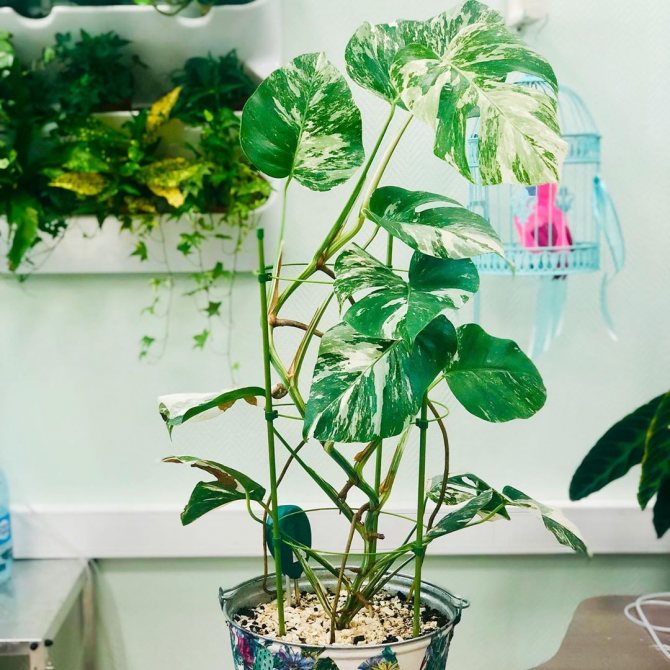

Monstera in design
Monstera flower: home care
For not too experienced lovers of green exoticism, monstera is a great option. She is so unpretentious that she easily tolerates agricultural mistakes. Naturally, you should not abuse her "patience" and it is better to grow it right from a young sprout right away.
If you manage to find a common language with a tropical guest, in a couple of years you can grow a large plant with leaves up to 40 cm in diameter. By donating part of his living space for him, the owner will be able to enjoy the emerald greenery of his carved foliage, which in some species becomes originally spotted.
How to water a carved-leaf plant
The tropical origin of the monstera "dictates" the conditions of its keeping. The main thing is sufficient watering (once a week in summer, less often in winter) and a regular shower from a spray bottle.
This plant is very fond of water procedures, but the water must certainly be warm and soft. If it is too stiff, unattractive streaks will remain on the shiny foliage. In addition, the respiratory stomata through which the plant "breathes" will become clogged.
Monstera leaves, which often reach impressive sizes, collect dust on themselves, which must be removed as it accumulates with a slightly damp sponge.
Monstera lighting
Nature has given us not many plants that do well in the shade. Monstera is one of them. True, variegated forms are still better placed closer to the light.
But the most common type of this plant is - Monstera gourmet - tolerates shade, therefore, you can find a corner for it with a denser darkening.
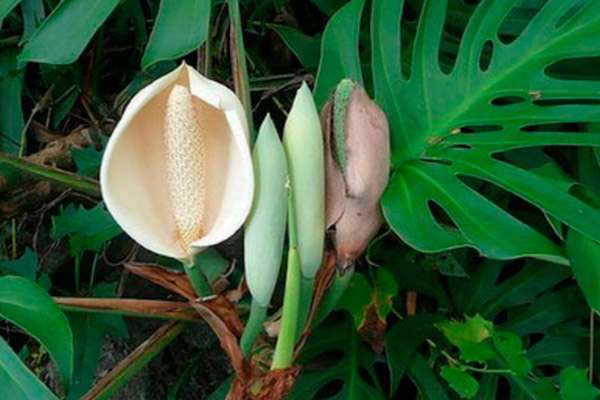

Temperature
The tropics are characterized by constant high humidity, diffused light and warmth. The ideal temperature regime for the summer period of life in a monstera room is 22-23 degrees.
It can be cooler in winter - about 16 degrees. At lower temperatures, root rot is possible.
Fertilizer (top dressing)
Even the most balanced soil depletes over time. So that our beauty does not feel hunger and receive good nutrition, we need to take care of this. I said at the beginning that the monstera is not capricious, and this is so. All she needs is feeding with a solution of a complex mineral fertilizer, which is suitable for almost all deciduous plants.
The frequency of such a "treat" is about once every 10 days. Variegated forms can be fed with a special mineralized cocktail designed specifically for them. You can buy it at your nearest flower shop. We fertilize the plant only on wet soil!
In winter, it winters well and on starvation rations. The result of dressing with a short daylight hours is the appearance of weak leaves, which often do not even form a carved pattern.
Care rules
The plant is unpretentious, you need a support, the role of which is played by a tube with moss. There are aerial roots on the liana, they should be tied to a support, directing to the ground, not cut off. The palm should not be placed on aisles where there are drafts, the leaves will turn yellow or acquire a brownish tint, then fall off.
- Temperature... The recommended temperature regime is within +16 - +22 degrees, for some time the monstera can withstand small temperature fluctuations. Flower growth activity depends on temperature, at +10 the plant feels normal, but growth stops. With increasing temperatures, the vine grows, and the leaves become large and carved, perforated.
- Shine... Direct rays of the sun have a detrimental effect on the liana; it is necessary to place the pot in a shaded place or choose an angle with diffused light.
- Watering... In spring and summer, the monstera needs good soil moisture. It is necessary to take soft, settled water, water the top layer of the soil will completely dry out.With the arrival of autumn, moisture should be reduced, in winter it is recommended to water it 2 days after the soil surface dries.
- Humidity... Monstera loves high humidity. It is necessary to spray the room and the palm tree itself from a spray bottle as often as possible, moisten the leaves, prevent dust from accumulating on them, wipe with a wet cloth. In winter, when it gets cooler, the moisture should be reduced.
- Priming... An earthen mixture is suitable: in equal parts, you should take earth, sand, peat and humus. The soil must be well drained.
- Top dressing... In the spring and summer, you need top dressing. They take fertilizers containing mineral and organic substances; dressings used for indoor plants are excellent. You need to add 2 times a month, this is enough so that the monstera does not stop its growth and development. Young plants do not need feeding.
Lighting
Contrary to popular belief, this vine does not at all like the dark corners of the rooms, where it is often placed. She is comfortable in a bright room near the window.
On the other hand, you should avoid placing the plant in full sun, because the leaves can get burned.
In low light conditions, the leaf of the plant becomes smaller, becomes whole, without irregularities and holes, the plant stops growing new shoots. It is worth noting that competent supplementary lighting with fluorescent or LED lamps allows you to grow a vine even in the complete absence of sunlight.
The source of artificial lighting is placed no further than 40-60 cm from the leaves of the monsterawhile choosing lamps designed specifically for growing plants. The light interval is set within a 12-hour day, allowing the plant to breathe at night and approaching the natural rhythm of life.
Botanical features of the plant
Monstera (Monstera) - large tropical plants, vines; genus of the Aroid family. The Monstera genus has about 50 plant species. Monsters are common in Central and South America. The gigantic size of the plant and its bizarre appearance served as the basis for the name of the entire genus (from monstrum - a monster, and, perhaps, "bizarre").
Monsters are evergreens, vines, shrubs with climbing thick stems, often hanging aerial roots. The leaves are large, leathery. The petiole is long, at the base it is vaginal. The inflorescence is an ear, thick, cylindrical. Flowers at the base of the ear are sterile, above - bisexual.
In general, monsters are unpretentious, it is quite easy to grow them, and maybe that's why these evergreen tropical vines with beautifully dissected dark green leathery leaves with cuts and holes of various shapes are among the most common indoor plants. You just need to take into account that even in indoor conditions, these plants stretch for several meters, so it is better to grow them in cool and spacious offices, foyers and halls. Can be used for shading (like climbing plants) and for trellises.
Monsters thrive in heated conservatories. The plant contributes to the ionization of the indoor air.
Watering
The plant is adapted to life with sufficient moisture. Therefore, rare or poor watering leads to crushing of the leaves, loss of turgor in them, the appearance of yellow-brown marginal spots.
How to water a monster: watered abundantly only when the top layer has dried by 5-7 cm, allowing the roots to breathe. Watering often, but in small quantities is not recommended, because it is easy to "flood" the plant.
In this case, the vine wilts, dark brown spots appear on the leaves, and a fungal infection of the stem may begin.
At low humidity, which is typical for our apartments, it is often necessary to spray the aerial roots of the plant, or direct them into vessels with water.
What to do with the roots
With the fact that the aerial roots of the monstera are far from a useless organ, we figured it out. And yet, when grown at home, they pretty much spoil the overall picture, hanging down with ugly brown processes to the very floor, giving the plant an untidy and unkempt look. To remedy the situation, there are several ways to deal with annoying roots:
- you can carefully tie the roots to the main stems as they form, so that they gradually reach the ground and can take root on their own;
- or place another couple of pots of earth near the container with the monster, and direct the root shoots into them. Then, after rooting, you will receive a few more young vines;
- you can arrange bottles of water so that rooting takes place not in the ground, but in water. In this case, it is important not to forget to change the water for fresh water in time;
- some wrap moist moss around the roots. This option also adds aesthetics, and makes it possible to begin the rooting process;
- horticultural stores often sell special plastic supports decorated with dried palm fiber. An overgrown liana can be fixed on such a support by making small holes in it to secure the air processes. Sometimes such holes are filled with earth or just regularly sprayed from a spray bottle;
- the aerial root shoots of the vine can be simply cut off. True, not all, and not completely. The plant will not be affected if you remove a small part of all aerial roots, or shorten them slightly to make the composition more attractive. Of course, you should not remove absolutely all the processes - in this case, the monstera can get sick or even die. The smallest problem that you will encounter in this case is yellowing of the leaves and a decrease in the vitality of the plant.


So there are many safe and effective ways to transform your tropical beauty. The main thing is not to get rid of the processes as soon as they appear. If nature provides for such an organ, then the plant needs it.
Just keep track of the growth of the roots, and in time, direct them where you need to. So you will save the monster from diseases, and give your favorite flowerpot a truly elegant and blooming look.
The soil
For planting, monsters use a mixture of garden soil with peat, sand and compost. (3: 1: 1: 1). Sand can be replaced with vermiculite or perlite. Be sure to lay a drainage layer (expanded clay) on the bottom of the container.
For planting the plant, you can use other earthen mixtures. It is important that they are nutritious enough, loose and retain moisture well. Good results are obtained by a mixture of garden soil of humus, sand and peat in equal parts. And here is another soil composition suitable for a plant in a ratio of 3: 1: 1: 1: 1:
- Sod land;
- Leafy land;
- Humus;
- Peat;
- Baking powder.
Is it possible to keep the monster at home
Why you can: useful properties and signs
- Thanks to its large leaves, the monstera plant actively produces oxygen, evaporates moisture, thereby improving the indoor climate.
- Monstera flower actively purifies the air (absorbs electromagnetic radiation, formaldehyde vapor).
- Monstera is recommended to be placed in offices, classrooms, libraries. This is due to the fact that the energy of the plant has a beneficial effect on the nervous system: it puts in order thoughts, harmonizes the state of mind, helps to concentrate, and contributes to making informed decisions.
- Also, the plant has a tonic effect on the body.
Why not
The monster should not be placed in the sleeping room, since the process of photosynthesis occurs at night (oxygen is actively absorbed, which is unfavorable for a sleeping person).
Fertilizer
Fertilizing the plant is necessary to ensure intensive growth and effective appearance of the leaves.
In the summer, the plant is fed 2 times a month., using liquid complex fertilizers "For decorative leafy plants".
With its rapid growth, it will also respond to watering a mullein solution, which you can pamper a beauty with 2 times a season.
With the onset of autumn, the plant is monitored and, in the case of active vegetation, they continue to feed once a month.
Features of growing monstera - briefly about the main thing
Temperature. Moderate, in winter the optimum temperature is 16-18 ° C, at higher temperatures, monstera grows rapidly.
Lighting. Does not tolerate direct sunlight. Many people believe that the monstera is shade-loving and put it in the darkest corner - this is not right. In fact, the monstera is shade-tolerant, and the best place for it is where there is bright, but diffused light or light partial shade.
Watering. Abundant - from spring to autumn, watered in winter so that the soil does not dry out, but is not waterlogged.
Fertilizer. From March to August, monstera are fed with complex fertilizer for indoor plants. Top dressing every two weeks. For large plants, humus can be added to the top layer of the earth once a summer, with or without transplantation. Instead, you can still water with mullein infusion, but at the same time, a smell may remain in the apartment.
Air humidity. Regular spraying. From time to time, monstera leaves are washed, wiped with a sponge and polished. When kept in winter near the heating system, leaf tips may dry out and stains may appear.
Reproduction. Air layers and cuttings. The cut should have a leaf and an aerial root. When the monstera grows very large, the top with one or more aerial roots is cut off and planted as an independent plant, while the mother plant continues to grow further.
Transfer. A young monstera is transplanted annually. Monsters over 4 years old are transplanted after 2-3 years, but the top layer of the earth is changed annually. Soil: 2-3 parts of sod, 1 part of peat land, 1 part of humus, 1 part of sand.
Young plants can be grown in a bucket, but plants older than 2-3 years will need a larger container. It can be either special flower pots (there are some on sale - huge sizes) or wooden tubs. Failure to provide a large monster with a suitable planting capacity is a common cause of problems associated with getting a beautiful and healthy plant.
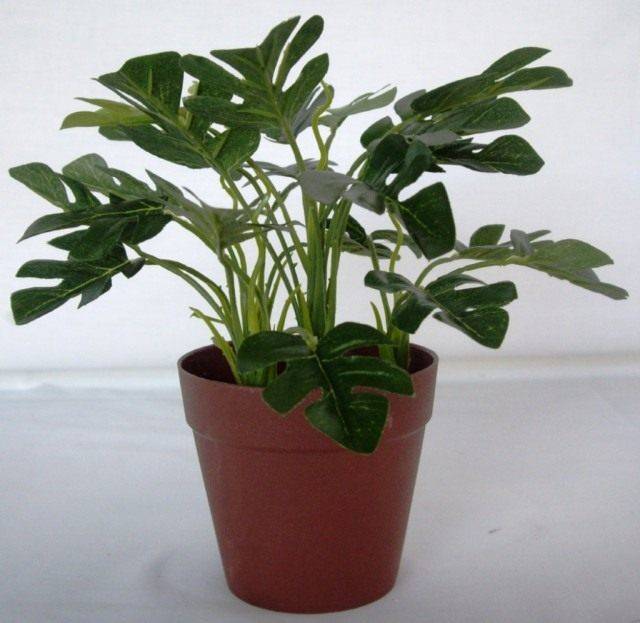

Monstera
Humidity
If there is an opportunity to increase the humidity of the air, the plant will thank you with powerful beautiful foliage.
Moreover, it will actively absorb air moisture with numerous adventitious roots.
To preserve moisture, the monstera support is wrapped with a thick layer of moss (sphagnum) and placed next to the plant, fixing the "ropes" of the roots on it.
Moss perfectly retains moisture and releases it gradually. The coconut fiber option is less successful, since its water-holding capacity is lower.
What to do with aerial roots: an alternative to pruning and useful tips from florists
As mentioned above, many growers are strongly against pruning monstera. What to do in this case with aerial roots?
To solve the problem, you can do the following:
- Bend the branches of the liana downwards, securing them so that they take root in the ground.
- Place containers of water next to the pot and lower the roots there, wrapping them in wet moss. In this case, the processes will help provide the monster with moisture, and will not interfere with caring for it. And you can also fill the flowerpots not with water, but with soil.
- Purchase a special support that will help keep the aerial roots in one position or do it yourself.To do this, you need to drill holes in a plastic pipe with a diameter of 10 cm so that the processes can fit there, then bury the lower end of the support in a pot and thread the "mustache" inside. And in order to provide the plant with nutrition, the pipe is filled with nutritious soil, which will need to be periodically moistened.
In order for the monstera to grow normally and still look exotic, it will be necessary not only to properly handle the processes, but also to follow some rules of care. This plant needs periodic feeding with complex fertilizers, as well as protection from direct sunlight. At the same time, it is necessary to ensure that the monster has enough light, and it will remain beautiful and healthy for many years.
Features of the
All varieties of monstera have similar recognizable features:
- The foliage on one specimen has a different shape: in the young it is whole, in the more mature it is dissected or perforated. This feature is called heterophilia (variegation);
- The plant "cries" before the raindropping drops of moisture from the leaves. The phenomenon is explained by the fact that the monstera removes excess liquid with excess air humidity through special holes at the ends of the veins - hydrodes. It is believed that such an interesting property of vines can be used to predict the weather;
- Aerial roots often grow at the base of the monstera leaf.that help the plant absorb nutrients and water;
- If the flower grows in comfortable conditions for her, she is able to bloom, giving out an inflorescence of white-light green color with a flower-cob inside. Outwardly, such a flower looks like a spathiphyllum. Sometimes cobs can be set.
The monster shouldn't be kept in the bedroom.
What are they needed for
Aerial roots for indoor monstera are an additional tool for obtaining moisture: under natural conditions, this tropical plant grows in a climatic zone where torrential warm rains often occur, and therefore the air is extremely saturated with moisture. Thanks to the aerial roots, the vine can receive additional moisture not only from the soil, but also directly from the surrounding air, which is of great importance for the normal development and full life of the plant.
There is a direct relationship here: the more air roots a vine has, the more powerful, beautiful and healthy it will be. And under especially favorable conditions, it can even please with flowering. So aerial roots are definitely the right organ for a tropical beauty.
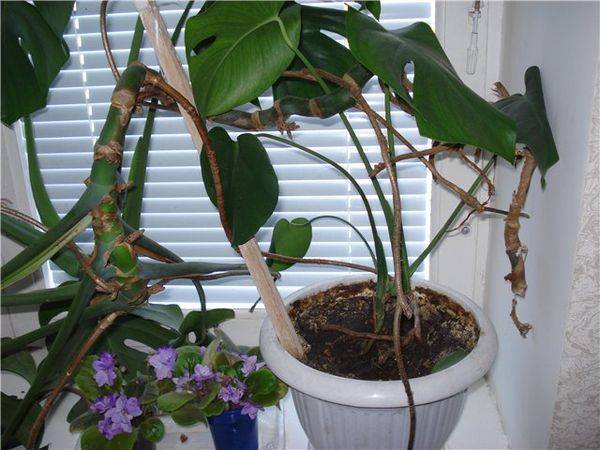

Trim / Support / Garter
How to prune a monster at home? Pruning a plant is not difficult. If the plant grows quickly and releases new shoots, then it does not need pruning.
But it happens that liana greatly slows down growth. Then the tops of the long shoots must be cut off in order to stimulate branching and the emergence of new shoots. Only the very top of the shoot is cut off, without affecting the aerial roots that the monstera lets out near each leaf.
Monstera - climbing vine... Only at a very young age does she need support. Usually, the support is placed in the center of the pot during regular plant transplanting. It can be an ordinary or bamboo stick, which is wrapped with sphagnum moss on top. This coating absorbs moisture, stimulates the growth and formation of aerial roots. You can also buy a special support from a flower shop.
The stem of the plant can be leaned against a support. But to keep the vine well on it, it is better to tie it up. The plant is fixed with a thick twine. It is attached to the support, not tightly tying the shoots.
How to recognize aerial roots
Before deciding what to do with the notorious roots, they need to be recognized. An inexperienced grower may decide that these are not roots, but new stems.Aerial roots form on the stems as the plant grows. As a rule, they grow opposite the leaves, have a slightly thickened, lignified structure. Such processes are colored not green, like the main stem, but light brown. Often, these roots grow to impressive lengths, "spreading" to the floor near the pot.
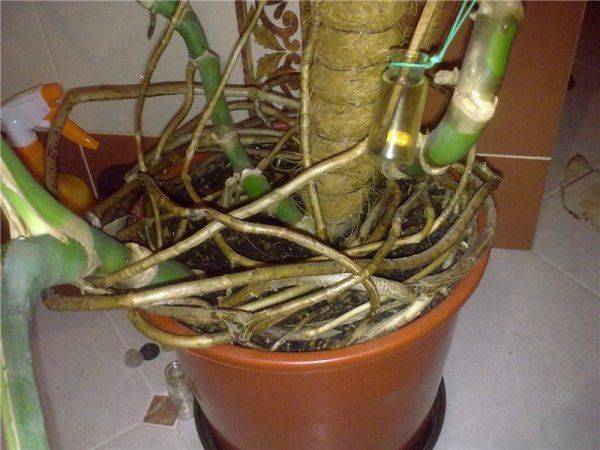

Diseases
Monstera is affected by diseases of bacterial and fungal origin. The most common causes of bacteria are stem rot and leaf blight.
When the trunk decays, its affected parts become soft and watery, acquire the smell of rotten fish. With spotting, black spots appear on the leaves of the plant, surrounded by a yellow rim. Plants are treated with copper-containing preparations (Bordeaux mixture, copper sulfate solution). All affected parts must be removed.
Diseases caused by pathogenic fungi are dangerous for the plant. The most common ones are:
With anthracnose, the leaves of the plant are covered with dark spots surrounded by brown and bright yellow halos. Fusarium causes rotting of the trunk with the appearance of red globular formations on it. Late blight causes rotting of the root system and trunk.
For treatment, antifungal drugs are used, with which the plant is treated until the symptoms of the disease disappear. The affected areas of the plant must be removed to healthy tissue.
Often harmful insects breed on the vine.... It is affected by spider mites, mealybugs, scale insects. Insecticidal preparations are used to destroy pests.
Possible difficulties in growing monstera
- In the shade, the growth of the monstera stops, the trunk is exposed.
- Brown spots on the underside of a monstera leaf are caused by red spider mites.
- Due to lack of nutrition, monstera leaves turn yellow.
- Due to waterlogging, the soil may turn yellow and even rot the leaves.
- Due to too dry air or too tight a pot, the tops of the lobes and the edges of the leaves of the monstera become brown and papery.
- With an excess of sunlight, pale leaves with yellow spots are formed.
- With a lack of light, small and pale leaves grow, the shoots lengthen, the stem of the monstera begins to twist.
- If the soil is too wet, monstera leaves "cry" (drops of moisture appear on them) - let the soil dry out and increase the intervals between watering. The appearance of drops on the leaves can also occur before the rain.
- When plants are kept in a dark place and with a lack of nutrients, the emerging monstera leaves have a solid plate.
- With age, the lower leaves of the monstera always fall off. But if, before falling off, the leaves become dry and brown, then the reason for this is too high an air temperature.
- Older plants form many aerial roots. They should not be removed, it is advisable to direct them into the substrate, into a pot or tub. As noted, they contribute to better plant nutrition.
- Monstera can be damaged by aphids, spider mites, scale insects.
Looking forward to your advice on how to grow these beautiful plants!
Problems
It happens that the lower leaves of the plant begin to become covered with brown spots and fall off. This is often associated with overflow.
It is worth transplanting the plant into fresh soil by placing 1-3 tablets of the fungicide Gamair into the planting hole or spilling the vine with Fitosporin solution. Rotten roots must be cut, processing cuts with crushed coal.
Often the tips of monstera leaves dry out. This can happen for a variety of reasons. It is most likely that the plant is in a draft. Also, leaf tip necrosis can occur due to a sharp drop in temperature or very dry indoor air.
Monstera does not tolerate watering with hard water... Because of this, its leaves can deform, and the growth rate of the plant itself is significantly reduced.
Dry brown spots sometimes appear on the leaves of a vine if it is in direct sunlight.These are sunburns. You need to put the flower further from the window.
In the absence of a regular transplant, the plant begins to lose the lower leaves. If the vine is not transplanted into a spacious container with fresh soil, then it will lose its decorative effect, and over time it may die.
Answers to frequently asked questions
- Why does the foliage of the plant turn yellow and fall off? There may be several reasons for this phenomenon. It is necessary to pay attention to the dryness of the indoor air. If the room is hot, ventilation is very rare, and yellowing of the foliage is possible.
- Why do brown spots appear on the monster? Improper watering contributes to the appearance. Monstera suffers from dry soil. It is recommended to water the flower and the problem will disappear.
- For what reason does the foliage turn pale and then become transparent? This problem may be due to two factors: the plant does not have enough iron, or the pot with the monster is in the very sun.
To grow a beautiful plant with huge carved foliage, you need to take proper care of the monster, which consists in choosing the right location, watering, lighting, pest and disease control.
Reproduction
Monstera are propagated by sowing seeds and vegetatively.
There are several vegetative breeding methods for monstera:
- Division of the rhizome;
- Cuttings;
- Reproduction by layering.
Seed propagation at home is practically not used... The plant rarely forms seeds when grown at home, and buying them is impractical, since they quickly lose their germination.
In the presence of fresh seeds, monstera are germinated in moist sphagnum under a film before planting. The temperature should not be lower than 25 ° C. After 35-60 days, sprouts appear, which are planted in the ground. They develop very slowly.
By dividing the rhizomes, only adult overgrown vines with many growth points are propagated. The procedure is carried out during the spring plant transplant. The rhizome is cut into several parts. There should be a growth point on each division. All sections are sprinkled with crushed activated carbon and dried for 2-3 hours. Then each part is planted in a separate pot.
When grafting in spring or summer, the adult monstera shoot is cut into pieces.... Each piece must have 1 node with a powerful, intact leaf. The cuttings are dried for 1 hour, and then put on rooting in boiled water at a temperature of about 25 ° C. They take root within a few weeks. After root formation, the cuttings are planted in separate pots.
Aerial roots are formed on each shoot of the monstera. It is enough to dig in such a shoot in a separate pot or container to get the cuttings. When it is well-rooted, it needs to be separated from the mother plant.
Reproduction methods
There are several ways to breed monstera:
- Cuttings- it is necessary to take a piece of the stem, on which there will be 2 buds, put it with a bud on the surface of the earth, do not bury it, sprinkle it with soil. In order for the roots to appear, the cutting must be constantly sprayed and watered, covered with polyethylene to create the optimal temperature regime. Periodically, the film should be removed for ventilation. When the cutting takes root, it is transplanted into a pot for permanent residence.
Monstera stalk Leaves - the leaf must be placed in a container with water and wait for the roots to appear, and then put in a pot.
Reproduction of monstera leaves
- Air roots - shoots with well-developed aerial roots are selected and, without cutting off from the stem, create a moist environment for them. For example, tie a moss that needs to be moistened regularly. From above, the moss and trunk must be loosely tied with a piece of film, thus ensuring constant moisture. When the roots grow and become strong, an incision is made in the stem and the shoot is separated, then planted in a pot.
Transfer
Monstera transplant at home is carried out in the spring in mid-April. Young plants need to be replanted annually. Lianas 3-5 years old need a transplant every 2 years. Large adult plants need replanting every 5 years.
The plant is transplanted by the transshipment method. Before transplanting, it should be watered so that the earthen lump does not crumble. A day after watering, the flower is carefully removed from the pot.
Before transplanting to a monster, you need to choose the right pot.
When choosing a new pot, you should not take too spacious. It is enough if its diameter is 2-3 cm larger than the diameter of the previous pot. Drainage is poured at the bottom with a layer of 4 cm, and on top - a little fresh soil.
The plant is placed in the center of a new pot.... The empty spaces between the earthen lump and the walls are filled with fresh soil, which is lightly tamped with a long stick or pencil. On top of the old earthen coma, no more than 2 cm of new potting soil can be poured. After transplanting, this flower needs to be watered well.
During the first week after transplanting, it is not watered. Then the watering regime, which is usual for this plant, is gradually resumed.
Video "Transplant room monstera"
From this video you will learn how to properly transplant a room monstera.
grow-
With the fact that the aerial roots of the monstera are far from a useless organ, we figured it out. And yet, when grown at home, they pretty much spoil the overall picture, hanging with ugly brown processes to the very floor, giving the plant an untidy and unkempt look. To remedy the situation, there are several ways to deal with annoying roots:
- you can carefully tie the roots to the main stems as they form, so that they gradually reach the ground and can take root on their own;
- or place another couple of pots of soil near the container with the monster, and direct the root shoots into them. Then, after rooting, you will receive a few more young vines;
- you can arrange bottles of water so that rooting takes place not in the ground, but in water. In this case, it is important not to forget to change the water for fresh water in time;
- some wrap moist moss around the roots. This option also adds aesthetics, and makes it possible to begin the rooting process;
- horticultural stores often sell special plastic supports decorated with dried palm fiber. An overgrown liana can be fixed on such a support by making small holes in it to secure the air processes. Sometimes such holes are filled with earth or just regularly sprayed from a spray bottle;
- the aerial root shoots of the vine can be simply cut off. True, not all, and not completely. The plant will not be affected if you remove a small portion of all aerial roots, or shorten them slightly to make the composition more attractive. Of course, you should not remove absolutely all the processes - in this case, the monstera can get sick or even die. The smallest problem that you will face in this case is yellowing of the leaves and a decrease in the vitality of the plant.
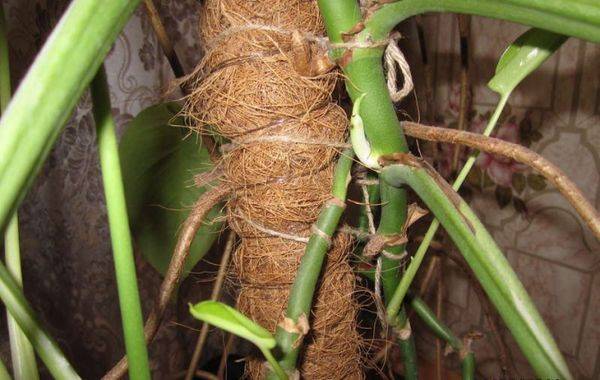

So there are many safe and effective ways to transform your tropical beauty. The main thing is not to get rid of the processes as soon as they appear. If nature provides for such an organ, then the plant needs it.
Just keep an eye on the growth of the roots, and in time, direct them where you need to. So you will save the monster from diseases, and give your favorite flowerpot a truly elegant and blooming look.
podokonnik.
Description of the species and varieties of plants
Several types of monstera are grown in room culture. The most popular ones are:
- Monstera is delicious;
- Monstera oblique;
- Monstera punched.
Monstera gourmet - the most common type, grown indoors.This variety was so named because of the delicious berries that are eaten in its homeland. It has long, flexible shoots reaching several meters in length. Its leaves are round and large, they have a diameter of up to 50 cm and are strongly dissected.
Monstera oblique - a smaller and more compact plant. Its leaves reach a diameter of 30 cm. They are not so strongly dissected and have a more elegant pattern.
Monstera punched - not a common species. It can only be found in tropical vine lovers. The leaves of this variety are elongated, with a pointed tip, have oval holes of different sizes, sometimes quite large. This shape of the leaves gives the plant a very elegant and unusual look.
Photo of a monstera in the process of home care:
Types of monstera
Under natural conditions, up to 30 species grow, only a couple of varieties are suitable for growing in indoor conditions:
- Monstera is delicious. The most common species that is found in almost everyone who grows a monster. Tall plant with huge leaves.
- Monstera is unequal or oblique. Miniature, graceful plant with oblong leaves. It got its name from the lack of symmetry. The length of the leaves reaches 20 cm, and the width is only 6 cm.
- Monstera Variegata. Variegated form. A characteristic feature is the small size and beautiful green-gray foliage with swirls and white inclusions.
- Monstera Adansona. You can find variegated and green forms. Yellow stripes are beautifully scattered over the ovoid foliage.
Features of an exotic flower
Monstera belongs to the Aroid family. It is found naturally in South and some regions of Central America, as well as in a number of Asian countries, where it is grown for the purpose of obtaining edible fruits. About 50 varieties of the plant are known.


Description of leaves, flowers, fruits
The leaves of the plant are fleshy, large, in nature - up to a meter in diameter. The color ranges from light to dark green; there are specimens with marble colored plates. The first leaves grow small, characteristic holes appear on them as they grow. In the future, monstera forms large leaves with oblong cuts along the entire width. First, they are assembled into tubes, which open into a formed plate. Over time, they become pinnately dissected, with noticeable veins and stripes.
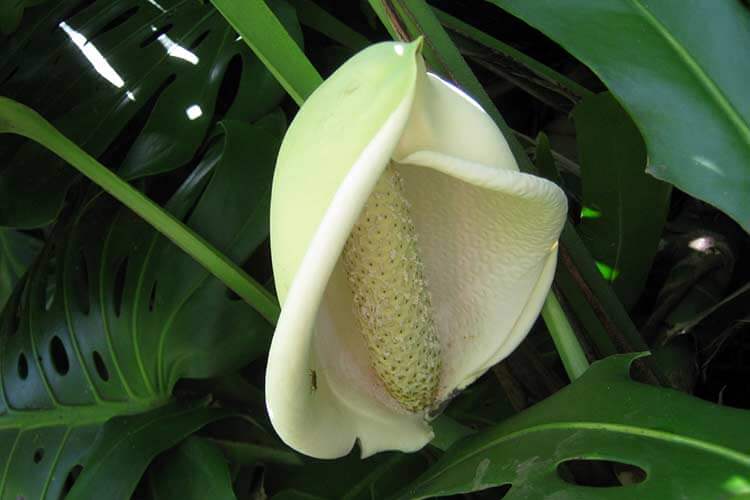

When flowering, the plant forms a cylindrical inflorescence, reminiscent of an ear of corn and wrapped in a kind of white-cream blanket. After a while, the fruit ripens - a berry 20-30 centimeters long, with a thick skin and juicy pulp. The fruit is edible and tastes like pineapple, banana and mango at the same time.
Brief description of cultivation
When grown in an apartment, the monstera quickly grows to the ceiling, while occupying a significant area and width. Therefore, you should give the plant its corner in the house in advance, not expecting that it will take root for a long time on the table or windowsill.
The flower lives for about 10 years. Needs bright diffused light, regular watering, top dressing and annual replanting.
Outdoor watering
In open soil, tomatoes should be watered in almost the same way as in a greenhouse. But there are some differences:
- You can also water over the leaves.
- Watering is best done in the evening about 2 hours before sunset.
- You can not water, but mulch the soil surface.
Remember to water the tomatoes less often and more abundantly.
The concept of proper watering of tomatoes is rather vague, as you can see there are some differences in care depending on the environment, but general points are still present. Timely and high-quality care will provide you with a rich harvest, so apply our advice in practice, and the result will not keep you waiting long.
I got interested and decided to get acquainted with the owners of this miracle, who told me about their secret of growing a culture.
The essence of the method lies in the fact that the main work on preparing the holes for growing tomatoes is carried out in early spring, when nothing grows on the site.
And another important point - much less time is spent on the garter of plants grown in this way than with any other. For those who do not really like to tinker in the garden, this method is just right.
At a distance of 1.2-1.3 meters from each other, holes are dug with a depth of 30 and a width of 45-50 centimeters. The land from them is laid along the perimeter.
The bottom is loosened to a depth of 15-20 centimeters, so it will be easier for the roots to wade through the soil: the deeper the roots go, the better the plant will be supplied with moisture, less watering will be required and the likelihood of top rot due to drying out of the soil will significantly decrease.
A strong stake 2-3 meters high is driven into the center of the holes, one bucket of half-rotted manure is poured, a bucket of humus or forest land is added on top, then a bucket of sand. The earth, previously taken out of the holes, is poured to the top with the addition of one-third of a 250-gram glass of nitroammophoska and a half-liter can of ash.
The contents of the hole are thoroughly mixed, and a solid side 6-8 centimeters high is made from the remaining soil around. The hole is ready - from 3 to 5 bushes of plants of the same variety are planted in it.
I dig out seedlings from the greenhouse with a height of at least 55-60 centimeters. I shake the roots off the ground and cut them in such a way that they freely pass, without bending, into the hole made. I cut off the lower leaves, leaving 3-5 on top.
I lower the plants into a hole made in the ground. Having filled all the holes in the hole with seedlings, I take a watering can, remove the mesh from it, and wash out the ground with a strong jet of water so that it evenly fills all the holes with seedlings. I spend a watering can on the hole.
After the seedlings are planted, I mulch the soil in the holes along the upper edge of the side with any available material: rotted sawdust, leaves, chopped straw, husk from seeds, etc.
If this is not done, then you will have to carry out 2 times more watering and after each loosen the topsoil.
Mulch, on the other hand, allows you to retain moisture and protects the roots of plants from overheating. Many earthworms are bred under it, which will loosen the ground without injuring the roots of plants, and also fertilize them with the products of their vital activity.
After that, all plant care is reduced to the garter of the stems. Moreover, all the plants are tied up with one ribbon or twine.
Among the whole variety of indoor plants, there are a considerable number of flowers with aerial roots. The most common: ficus, bastard (family, it is also a money tree) and monstera. The most famous are orchids, even those who are not inclined to cultivating a home garden are aware of them. The aerial root is very useful for both the plant and its owner. The latter, according to the presence, development and appearance of an additional plant organ, can draw very specific conclusions about its health. However, it should be borne in mind that aerial roots impose certain responsibilities for caring for the plant. And although their execution is not too troublesome, you should not forget about them.
Growing problems
In indoor floriculture, difficulties can be encountered when growing any flower; when caring for a monster, problems and unforeseen difficulties also occur.
The appearance of dry brown spots on the edges of the leaves suggests that the soil moisture is insufficient, if the spots continue to grow, this may be a sign that the air in the room is dry, it should be humidified.
The browning of the leaves and the appearance of cracks on them indicate the content of the flower in a cold and damp room.
The pale green color of the leaves with further yellowing probably indicates the development of chlorosis. You will need foliar feeding with one of the preparations containing iron (iron chelate) as an ambulance, root feeding with iron sulfate. Such a state can also be with an excess of bright sunlight.
The leaves not only turn yellow, but also crumble - keeping the flower at high temperatures and low humidity. It is necessary for the monster to remove it from the heating devices, lower the temperature, and spray the foliage more often.
The trunk at the bottom of the plant remains the same thickness as the stem taken for propagation. If the lower trunk turns out to be very thin compared to its upper part, you can try to deepen it by sprinkling it with a layer of earth, thus protecting it from breaking.
The best time to transplant monstera
It is very important to replant this plant in time: if the rapidly growing roots clamp an old and narrow pot, the monstera will not be able to form new leaves (or they will become smaller and more inconspicuous), its trunk will become naked and elongated. And if the flowerpot is also shoved into a distant, poorly lit corner, it can start to turn offensively and ugly yellow.
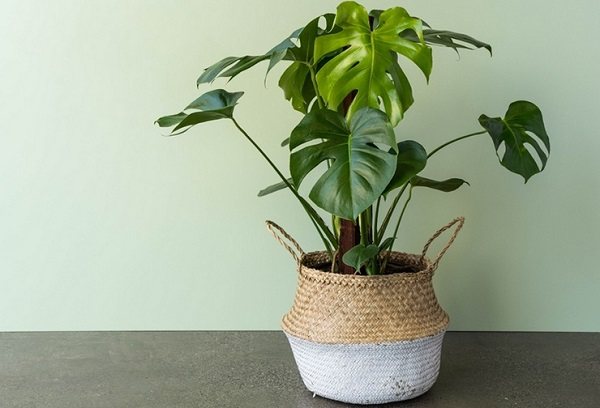

Monstera is transplanted in early spring.
- A young plant (up to three years of age) is transferred to a new pot annually, and the "house" in each case is bought a little more than the old one.
- Mature exotic (4-6 years old) are transplanted even more often - from three to four times a year. The fact is that it is at this time that the monstera grows most rapidly. By the way, it is better to work with such a flowerpot together - this way you minimize the risk of the flowerpot falling. It is already quite heavy, and it can be difficult to keep the overgrown "little body" alone.
- The old man need not be disturbed by transplants at all. Moreover, this would be extremely problematic, because in size such a monster can resemble a real tree, and trying to dig it out of your native tub, you only injure your green pet. But do not let the soil in the container become salted and completely depleted, collect the upper part of the soil and replace it with fresh one.
Requirements for conditions
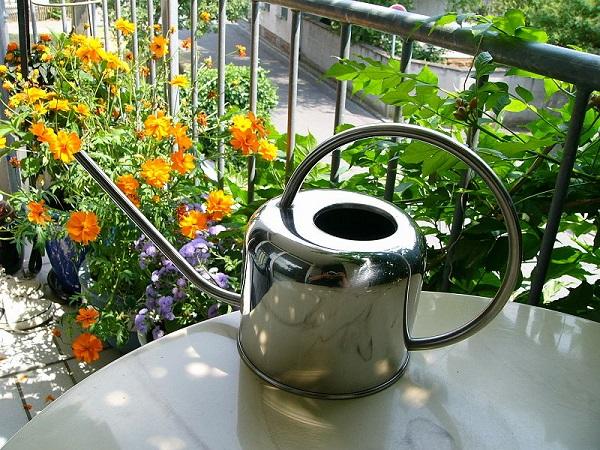

Monstera is unpretentious to the conditions, as already mentioned, it is quite simple to take care of her. When choosing a place for a plant, several factors must be taken into account:
- Air temperature;
- Humidity;
- Illumination.
Monstera is a thermophilic flower. Therefore, it is worth taking care that the room is always warm and the air temperature does not fall below 16 degrees. The most optimal temperature for flower growth is 23-25 degrees. In winter, to maintain the required mode, you can use special lamps or heaters for the plant.
Monstera is a plant from the tropics where the air is humid. Therefore, the flower positively perceives regular spraying and high humidity. You can spray it once every couple of days or on watering days. But do not get carried away with water procedures in order to avoid diseases of the roots of monstera. In winter, at low temperatures, spraying should be abandoned.
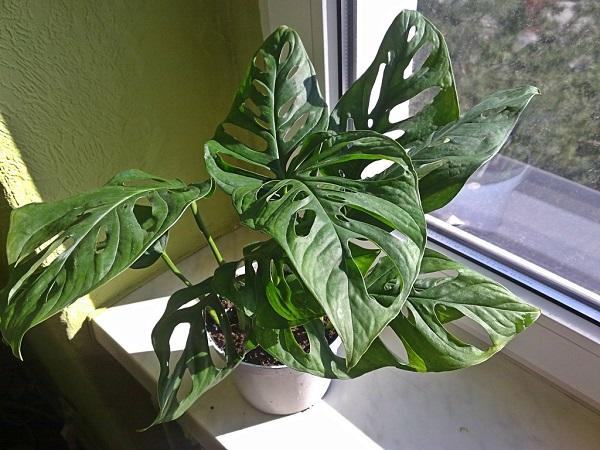

The plant is recommended to be placed on a window or left on a balcony, where there is bright lighting and diffused light. If sunlight does not penetrate well into the apartment, you can use special lamps.
Why are monstera leaves not cut
The main beauty of the monstera is its unusual carved leaves. Gardeners can't wait to see them on their plant. But it turns out that they are young, just grown and opened leaves without cuts and holes. The long-awaited openwork appears in older leaves: first, cuts, and then cuts are formed.
Know! Openwork holes and cuts are individual for each individual plant, so growers can proudly declare that their monstera is the one and only, there is no identical to it.
The leaves of such a picturesque plant can grow whole for the reason that it is contained in the shade.It is worth changing the location of the flower, and after a while the leaves will begin to form cuts.
Aerial roots of monstera: their role in plant development
In the wild, the outer roots provide an additional source of moisture, which the plant can obtain from the vapor-saturated tropical environment. Reaching the ground, air appendages tend to take root in the soil, thereby contributing to increased nutrition for the monstera, which makes it stronger and more resilient.
Aerial roots of monstera serve as additional nutrition
Monstera is a very moisture-loving plant, so you need to prevent the soil from drying out. But you should know that excessive watering will also negatively affect its condition - the roots may begin to rot
Monstera belongs to the type of lianas and in favorable conditions can reach a length of 20 m. For some types of monstera, aerial roots serve as a support. As they grow, they become lignified and tough, which allows the plant to become more resilient. Florists use air layers to propagate monstera. To obtain a positive result, the root and leaf must be on the layer. In this case, the layering can be planted directly into the soil, it will quickly take root.
Plant propagation
It is quite possible that soon the florist will want to propagate the plant, or friends will ask for seedlings. Hence, it is quite reasonable to find out which method is best to use to obtain planting material.
Layers
The easiest way to get young seedlings of an evergreen plant is by air layers. It is enough to wrap the desired stem with wet sphagnum, wrap it with polyethylene on top, fasten the edges with clothespins or tie it with a thin soft wire. After the formation of roots, the stem is cut off from the mother plant and planted in a pot with prepared soil.
Cuttings
This method is the most common. It is necessary to take a part of the cuttings with at least two buds and lay them on a moistened ground. The prepared earthen mixture should be very light so that it is easier for the roots to break through and cling to it. Wet sand works well.
It is enough for the stalk to touch the ground with one bud, moisten well, cover with a film or jar and put in a warm place. The best time of the year for propagation by cuttings is the beginning and middle of spring, when the plant begins to grow actively.
In order for the cutting to take root, it must be constantly sprayed, the soil must be watered, the upper shelter must be periodically removed for ventilation.
After a while, roots will appear, later - young leaves in the shape of a heart. To speed up the appearance of shoots with leaves, it is better to water the cuttings not just with water, but from time to time with the addition of growth stimulants.
It is not necessary to rush to plant seedlings in the ground with the appearance of the first roots, it is better to give it time to acquire a more developed root system, then when transplanted to a permanent place, the sprout will take root faster, and will begin to develop further more actively.
Seeds
Thus, it takes the longest to breed a monster. Only after two years a plant is obtained with four mature leaves and four to five young leaves. The seeds are sown in a box with wet sand directly on the surface, moistened, covered, the box is placed in a warm and bright place. It is necessary to ensure that the surface of the sand is always moist.
After about a month, sprouts will begin to appear. With their appearance, the film must be removed. The grown seedlings dive, then every year, until the age of four, they are transplanted into pots slightly larger than the previous ones.
Plant support
The monstera is also unusual in the sense that it needs one more help from its owner - to buy in a store or make a support for the trunk itself, which would help the plant to maintain an upright position.If you allow the monster to develop in a horizontal plane, it will take up too much space.
It is very easy to make a support for a flower with your own hands:
- A plastic pipe with a diameter of 8 to 10 centimeters, approximately 1 meter long.
- Wrap the pipe with a thick layer of wet sphagnum. As you wind up, secure the sphagnum with fishing line.
- Leave the part of the tube entering the ground open.
- On top of the sphagnum, wrap the pipe with a green plastic mesh with a mesh size of 10x10 millimeters, and again fix it with fishing line.
- Stick the support into the flowerpot, attach the stems to it.
Pests
- Thrips (the surface of the leaf plates is covered with white specks, and small insects can be found on the reverse side);
- Scabbard (leaf plates dry, fall off, brownish plaques can be found on their surface - actually the pests themselves);
- Spider mite (leaves become lethargic, small cobwebs can be found on their surface);
- Mealybug (leaves, young shoots bend, dry, fall off).
First of all, it is necessary to remove pests mechanically. Moisten a cotton pad or sponge with soapy water, wipe the leaves. Then apply an insecticide treatment.
How to prune and transplant a monster
With age, the liana stretches, the leaves from the lower part of the trunk fall off. The plant needs rejuvenation. It is necessary to completely cut off the upper part in the spring, leaving about 30 cm. After a while, young shoots will appear. The top can be used for propagation: put it in water, and when the roots grow (it is desirable that they completely fill the container), plant it in the soil.
- Transplant young plants (up to the age of 4 years) annually, then transplantation is required approximately once every 2-3 years.
- Increase the size of the pot each time you transplant. The root system is powerful and requires space. Choose a deep, wide pot.
- The thickness of the drainage layer should be 1/3 of the container.
For planting, you can use a universal substrate, a mixture for palm trees, or prepare a soil mixture: turf and humus soil, peat, sand in equal proportions.
Frequently asked questions related to growing monstera
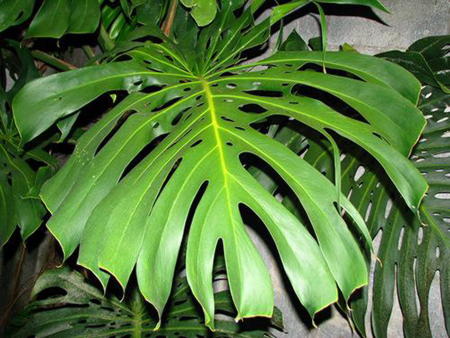

Can a monster be kept at home?
- Undoubtedly, this is a very beautiful houseplant. However, it needs a spacious, bright room with a constant temperature.
Is the monstera poisonous?
- No, the pet monstera is safe for both humans and pets. The only thing that can harm health is its unripe fruits, which can cause inflammation of the mucous membranes. But, as already mentioned, in room conditions, the monstera practically does not bear fruit.
Why do monstera leaves wither?
- Withering leaves can signal violations of temperature, humidity, or pest infestation.
Why do leaves dry?
- The leaves dry out if the plant lacks feeding, watering or spraying, or if the room is too hot.
Why is the monstera "crying"?
- On the leaves of the monstera, droplets of a transparent viscous liquid appear on the eve of rain. This plant can be considered a natural barometer and is able to “predict” rain for at least a day.
Orchid root system problems
These plants are much more delicate and capricious - they need special living conditions and special, rather troublesome care. Therefore, not every grower dares to start orchids on the windowsill, even despite their wonderful flowering. And the one who nevertheless made up his mind, but has not yet gained enough experience, is faced with problems that the aerial roots of the orchid begin to create in abundance for him. If in a monstera they can only begin to dry, and it is not difficult to deal with the reasons (as well as to eliminate them), then in capricious beauties the adventitious roots can not only dry out, but also rot. And often there is a need to reanimate orchids that are completely without aerial roots.
Getting ready for the transplant
Soil selection
Monstera is curious in that at different periods of life it requires a different soil composition. A young flowerpot prefers slightly acidic or neutral soil, mature and old ones prefer acidic (and the older the tree, the more acidifying substances, such as peat, should be in the soil for it).
Here are some soil recipes that experienced flower growers have recommended to me. Choose according to the age of your pet (recipes are indicated as the acidity increases):
- 3 shares of sod land, 1 share of deciduous soil and coarse sand;
- 2 shares of sod soil, 1 share of humus, river sand and peat each;
- 2 shares of humus, 1 share of sod land, sand and peat;
- deciduous and sod soil, humus, sand, peat in equal proportions.
Read also What is lapis lazuli used for
Which pot is right for you?
Each time the container must be larger than the old one.
For the first three years, while the plant is young, take a pot 10 or 15 cm larger than the previous one.
For 4-6 years of plant life, when it grows as quickly as possible, with each transplant, buy a "house" 20 cm larger than the old one.
Important: you do not need to buy a pot two or three times larger than the old one (for growth). The soil in it can sour or swamp, which will cause the plant to die.
As for the material, you can select different pots for a young plant, even light plastic ones. But the larger the flowerpot, the harder I would advise you to choose a container. The old "monster" can even be planted in a wooden decorative tub.
Do you need a support for the plant?
Yes! The larger the flowerpot, the more important support is for it.
This "stick" is installed in the pot during planting, resting against the bottom. As a support, most often they use a wooden bar or a plastic (stainless steel) tube wrapped in coconut fiber or twine for decorative purposes.
The support can be vertical, as in the photo above (with its help, the "monster" will resemble a tree) or horizontal. If the pot is gigantic, and the flowerpot matches it, you can install several supports at once.
An important point: it is important to install such a pole precisely when planting / transplanting. If you try to squeeze a support into a pot with a plant growing in it for a long time, you can injure its root system, and as a result, ruin the whole "monster".
Why do monstera turn yellow, dry and fall leaves
Improper care negatively affects the appearance of the plant:
- Leaves dry out from lack of moisture or nutrients.
- If the soil is waterlogged, the leaves begin to turn yellow, the roots rot - an emergency transplant is necessary.
- The trunk of a young plant is bare, the growth rate slows down - the lighting is insufficient.
- The edges of the leaf plates turn brown - the air is dry or the root system is cramped in the pot.
- When exposed to direct sunlight, the leaves are covered with yellow spots.
- The leaf plates remain intact - the plant does not have enough light or nutrients.
- The leaves turn yellow from the elevated air temperature, fall off (do not confuse with the natural gradual fall of leaves from the lower part of the trunk).
Planting and leaving
A stalk or layering that has developed its roots well needs to be planted in the ground. In order for the roots of the sprout to be able to develop further, providing it with nutrition, light soil with neutral acidity is needed. It is best for young plants to purchase a special peat soil with the addition of micronutrient fertilizers. Nothing will oppress the roots and the plant will quickly start growing.
You can not put young plants on the windows on the south side, direct sunlight will destroy it. Moderate watering and fertilization are required so that the young plant does not experience starvation, then it will fully develop.
The grown flower must be transplanted the next year. The soil can be prepared independently, for a strengthened root system and for the plant as a whole, minor omissions will no longer have tangible consequences.


Causes of the disease and the appearance of pests
The reason why the flower begins to hurt or is affected by pests is keeping in unfavorable conditions. Mistakes in leaving weaken the monster, she does not receive important substances or, on the contrary, takes them in excess.
Important! Sometimes the owners lose sight of the fact that in winter (from late autumn to early spring), watering should be significantly reduced and they continue to give the plant a summer amount of water.
Lack of water, the wrong place, lack or excess of sun, inappropriate temperature or humidity can lead to diseases. Pests can settle on the plant. Especially if street contaminated soil was used for transplantation.
Why do monstera leaves turn black
Monstera turns black due to stagnant moisture in the pot, which can be caused by insufficient drainage and / or over-frequent, heavy watering. The root system begins to rot, the rot spreads to the entire plant.
An emergency transplant with soil replacement and fungicide treatment is required. Free the roots of the plant from the soil, cut off the rotten ones, and plant in a disinfected pot with fresh soil. Be sure to add a drainage layer of small stones to one third of the pot. After transplanting, pour a solution of phytosporin and treat the leaves with it.
How to propagate with apical and stem cuttings
The stalk is cut, of course, from the crown of the flower. To facilitate the process, it is simply placed in water. After a few weeks, the cutting will take root.
Note! You need to wait until at least two roots appear, after which the plant can be planted in the soil.
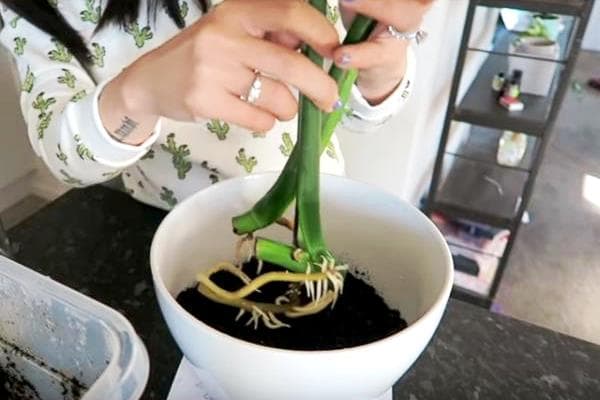

Propagation by cuttings
This method requires a good cut of the stem. The stem cutting should have two buds. To root it, you need a container of a suitable size with light peat soil, on which the cutting is simply placed bud side down. You do not need to fill it up.
Next, the cutting is placed under a transparent glass or film cover, sometimes sprayed, moistened, and ventilated. With the appearance of roots, the first leaf also grows. After rooting, the flower can be planted in a permanent place.
Note! This type of plant propagation is considered more practical among experienced gardeners.

